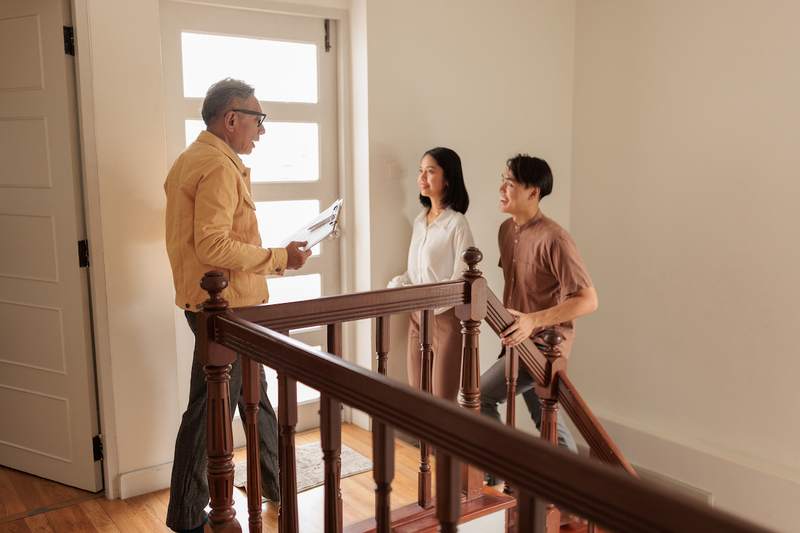Though home prices typically increase over time, there are areas of the country where buying a home is even more expensive than the norm.
The median home price in the United States in the second quarter of 2023 was $416,100 — well within the federal government’s conforming loan limit of $726,200 for a single-family home. But high demand and limited supply in densely populated areas can increase prices considerably, so the conforming loan limit in such areas is $1,089,299 — more than 2.6 times the national median home price.
Most first-time homebuyers will find it tough to buy in a more expensive area, but it’s not impossible if you understand the process and prepare for it accordingly.
Key Takeaways:
- More-expensive housing markets usually are found in urban areas and along the coasts. California is home to most of the nation’s priciest home markets.
- Affording a home in an expensive area may require a jumbo loan, which often has stricter requirements than other mortgage types. Costlier homes also require aspiring buyers to save more for the down payment and closing costs.
- Consider less-expensive neighborhoods in the area you want to buy, as well as less-expensive types of housing, such as a condo, townhouse, fixer-upper, or tiny home.
Where Is It More Expensive To Buy a Home?
Housing becomes more expensive where the supply of homes is limited and demand is high — typically because more people want to live there. Such areas may be more desirable for any number of reasons, including economic opportunities, or access to educational, cultural, and leisure activities.
In general, coastal areas and urban areas tend to have more-expensive homes than the rest of the nation.
Most Expensive Housing Markets by Median Sales Price
| City | Median Home Sales Price |
| 1. San Francisco | $1.4 million |
| 2. San Jose, California | $1.3 million |
| 3. Anaheim, California | $965,000 |
| 4. Oakland, California | $825,000 |
| 5. Oxnard, California | $781,000 |
| 6. Los Angeles | $774, 000 |
| 7. San Diego | $770,500 |
| 8. Salinas, California | $725,000 |
| 9. Santa Barbara, California | $704,500 |
| 10. Seattle | $700,000 |
The Federal Housing Finance Agency, which establishes the annual loan limits for conforming conventional mortgages, publishes a map showing areas with higher loan limits in the United States.
Tips for Buying a Home in an Expensive Area
The process for buying a home in an expensive area is similar to buying a home anywhere, but with the larger dollar amounts involved, it’s important to be as specific as possible to ensure you don’t buy a home that you can’t afford.
Honestly evaluate your finances
If you’re looking to buy a home in an expensive area, you first need to figure out how much house you can afford.
“Before diving into the market, potential buyers should thoroughly evaluate their financial situation,” says Rick Gruebele, owner of Visions First Realty, a Washburn, Wisconsin-based real estate brokerage. “This includes assessing their credit score, debt-to-income ratio, and overall budget. A strong financial foundation will make it easier to secure a favorable mortgage rate and loan terms.”
Start with your income. A rule of thumb is to spend no more than 28% of your gross monthly income on housing. For example, if you make $60,000 per year, that equals $5,000 per month in gross income. Applying the rule of thumb, 28% of that amount is $1,400, so you should aim to have a mortgage payment no larger than that.
For an expensive home, you’ll need much more than $1,400 per month. If you get a 30-year fixed-rate loan for $1 million at a 6% interest rate, the monthly payment would be $5,996. That doesn’t include costs such as homeowners insurance and property taxes, which also will cost more when buying a more expensive home. Using the 28% rule, you’d need a gross monthly income of at least $21,414 — which is a gross annual income of $256,971.
You need to think about your expenses as well. Lenders will calculate your DTI ratio to compare how much you make with what you owe on your debts. Reducing this number will help you get a loan by showing lenders you have room in your budget for a mortgage payment.
Cutting expenses on other items such as vacations, restaurants, and entertainment also will free up cash you can use to save for a home.
Understand your loan options
There are many loan types and programs aimed at helping borrowers buy a home, with generous requirements for credit scores, DTI ratios, and low minimum down payments.
However, if you’re looking to buy a home in a more expensive area, and an evaluation of your finances gives you a realistic shot at it, you may not qualify for such loans. Government-backed programs — including Federal Housing Administration loans, Veterans Affairs loans, and U.S. Department of Agriculture loans — are aimed either at specific types of buyers or low-income buyers. If you’re buying a more expensive home, these programs are an unlikely option for you.
The term for a loan that exceeds the FHFA conforming loan limit is a jumbo loan. Also known as nonconforming conventional loans, jumbo mortgages aren’t backed by the government and have no standardized requirements for borrowers. Lenders cannot sell jumbo loans to Fannie Mae or Freddie Mac, which means they are taking on all the risk of issuing the mortgage themselves.
This all adds up to each lender setting its own requirements for jumbo loans. Lending such large amounts of money means stricter qualifications and a more thorough mortgage underwriting process.
If you can afford a more expensive home, this may not make much difference. If you’re struggling to save up a down payment and your financial record has some nicks and dents in it, you either will need to wait until you can meet the requirements or consider looking for a home in a more affordable area.
Save for a larger down payment and closing costs
Buying a more expensive home means that you’ll need to save more money for a down payment and closing costs.
Different loan programs have different down payment requirements, but they’re generally a percentage of the home’s value. That means the minimum amount needed for a down payment will be larger the more expensive the home is. Making a 3% down payment on a $500,000 down requires $15,000 in cash, while a 3% down payment on a $1.5 million home would require $45,000.
“A larger down payment not only reduces the mortgage amount but also enhances the borrower’s financial credibility,” Gruebele says. “Saving diligently and aiming for a down payment of at least 20% can lead to better loan terms and lower monthly payments.”
Remember that, in addition to the down payment, you’ll need to pay closing costs on your home. Closing costs typically total 2% to 5% of the purchase price, so the more expensive the home you’re buying, the more you’ll need for closing costs.
Freeing up income to save for a home can be done by making more money and reducing expenses.
Make more money
Though it’s easier said than done, the most obvious way to save more for a down payment is by boosting your income. If you make more money, you can set aside more savings each month. Plus, it means more income that you can put toward your future mortgage payment and other expenses of owning a home.
There are a few ways to boost your income. One is to ask your employer for a raise or to work toward a promotion. You also could consider looking for a higher-paying job or taking on a side hustle, such as freelance work, getting a part-time job, or driving for a ride-hailing company like Uber or Lyft.
Reduce unnecessary expenses
Cutting out unnecessary expenses is another way to boost your ability to save for a down payment. Consider reducing spending on vacations, dining out, entertainment, or transportation.
Raise your credit score
Your credit score plays an important role in determining how much money you can borrow and the interest rate you pay on that debt. Raising your credit score is key to being able to afford a mortgage to buy a home in an expensive area, as a higher credit score will get you a lower interest rate.
Second, on a large loan, a small difference in interest rates has a big impact on your monthly payment. Imagine you get a jumbo loan for $1.5 million with a 30-year term. At a 6% interest rate, your payment will be $8,993 per month. At 7%, your payment rises to $9,980 per month — almost $1,000 more per month. Having less-than-excellent credit could make your home loan cost thousands more per year.
Adjust your expectations
Depending on where you’re hoping to live, your income, and your current expenses, the harsh reality is that you may have to adjust your expectations regarding where you can live or the type of home you can afford.
If you want to buy a home in an expensive area, consider buying a smaller home or a starter home that has fewer features, or a different type of home — such as a condo, townhouse, or tiny home. A fixer-upper also could be a good opportunity.
You’ll have to create a checklist of wants, needs, and must-haves, and then prioritize the things that are truly important to you.
Consider cheaper neighborhoods
Even expensive areas have some neighborhoods that are more expensive than others. If you’re looking to buy in a pricey city, consider looking at neighborhoods that are less popular to find cheaper homes.
For example, in 2022, home prices across the Boston area varied significantly. The median home in Boston itself cost $796,500. Just across the Charles River, the median home in Cambridge, Massachusetts, was more than double that price at $1.87 million. Malden, Massachusetts, a city just north of Boston with easy access to downtown via subway, had a median home price of $628,000.
Even within those cities, some neighborhoods had home prices well below the median. With some careful searching, you can find relatively cheaper homes even in expensive areas.
Look at less-expensive housing types
When people think of buying a home, the first picture that pops into their mind is often a single-family home with a yard and a fence. The reality is that single-family homes are the most expensive type of housing on the market, so consider whether you want to buy a house, condo, or townhouse.
Condominium
A condominium is a large building, much like an apartment complex, made up of multiple housing units. Unlike units in an apartment, which the property owner rents to tenants, each unit in a condo is owned by an individual.
There are a few perks to living in a condo. For example, you can benefit from shared amenities, such as a pool or parking garage. You also aren’t responsible for as much maintenance, and condos tend to be more affordable than other types of homes.
However, condo owners have to pay homeowners association fees, which are an additional monthly expense. Major costs incurred by the condo building, such as unexpected repairs, may result in additional assessments. You also have less privacy because you’re sharing the building with others.
Townhouse
A townhouse is another type of home that might be less expensive than a single-family property. Typically, townhouses are tall and narrow, with multiple floors, and located in urban areas. They share at least one wall with another residence and frequently are part of an HOA.
Townhouses provide a bit more privacy than condos because they’re much like single-family homes, simply sharing walls with neighboring homes. However, homeowners might be responsible for more maintenance, and they tend to be more expensive than condo units.
Multifamily home
A multifamily home is any building that has multiple housing units. Though technically apartment complexes count as multifamily homes, this term usually is reserved for homes that have two to four units.
Multifamily homes often are more expensive than single-family homes. However, they also can be more affordable overall if you consider that you can rent out the extra units — a practice known as house hacking.
“As the real estate market continues to rise and interest rates make the monthly payment amount unrealistic, many buyers are turning to house hacking,” says Daniel Pitner, a Glendale, Arizona-based Realtor. “Simply put, house hacking is purchasing a house where a section of the house can be used as a rental to offset the monthly mortgage amount. Traditionally this strategy is used for duplexes and multifamily units where the buyer can live in one unit and then rent out the other side.”
However, because multifamily homes tend to cost more, they require corresponding larger down payments. You also have to be willing to take on the work of being a landlord.
Single-family home
A single-family home is a detached building that houses a single family. It may come with amenities like a patio, deck, or backyard.
Single-family homes tend to be the most expensive type of home, and require the most financial responsibility and maintenance. However, they offer the most privacy and freedom compared to other types of housing.
Explore down payment assistance programs
If you’re trying to afford an expensive home, the down payment required can feel prohibitively expensive. Down payment assistance programs could help you get the money you need upfront.
These programs are often administered by local nonprofits or city governments. They can take the form of grants or loans to help qualified buyers make a down payment. For example, first-time homebuyers in Philadelphia can get assistance from the city’s Division of Housing and Community Development. Recipients can get grants for up to $10,000 to use for a down payment or closing costs.
However, many of these programs have income or asset limits, so they may not be useful if you’re looking to buy a home in a more expensive area that someone with low income can’t afford.
Shop around and compare mortgage lenders
The interest rate on your mortgage plays a big role in the affordability of your home. When you’re borrowing enough to buy a home, even a small difference in your interest rate can make a huge difference in your monthly mortgage payment.
That means that shopping around and comparing loan offers is essential.
Consult a mortgage broker
One way to find a good deal on a home loan is to work with a mortgage broker. Brokers aren’t lenders. Instead, brokers work with many lenders and know what terms they offer and the types of borrowers they typically approve. That allows brokers to connect buyers with the lenders that can offer the best deal.
A good mortgage broker can match you to lenders that work with people in similar situations, and can help you compare mortgage offers to find the best one available.
Look for an experienced real estate agent
When you’re buying an expensive home, it’s usually helpful to work with a seasoned real estate agent. Your agent can help you identify good opportunities in the area where you wish to buy. They also can give you a sense of which neighborhoods might fit your budget.
Experienced agents also can help you make a competitive offer without overspending.
Take a long-term view
If you’re purchasing a home at a high price, you need to think about the long term.
The longer you hold on to your home and pay down the mortgage balance, the more home equity you’ll build. Equity can provide access to enough cash to pay for major expenses, with a cash-out refinance, home equity loan, or home equity line of credit.
When you sell a home, you can expect to spend about 10% of your home’s value on transaction costs. Selling a home after only a few years of owning it means you’ll have little equity built up, and you’ll still need to pay transaction costs.
FAQ: How To Buy a Home in an Expensive Area
Here are answers to common questions about buying a home in an expensive area.
San Francisco has the highest median home price at $1.4 million, according to CoreLogic.
With a 20% down payment, you would borrow $800,000 to buy a $1 million home. At a 6% interest rate, your monthly payment before property taxes and homeowners insurance would be $4,796. To spend no more than 28% of your gross income on your mortgage, you’d need to have a household income of $17,128 per month, or $205,536 per year.
As interest rates change, the income required also changes. Lower rates mean that you can afford a $1 million home with a lower income, but higher rates mean you need to make more.
West Virginia is the cheapest state to buy a home. The average property in the state costs just $129,103, according to Mortgage Professional America, a trade publication for the mortgage and finance industries.
The Bottom Line on Buying a Home in an Expensive Area
Buying a home anywhere is a major expense, but if you’re looking to buy in a known high-cost area, you need to be ready for it. You’ll need sufficient income, excellent credit, and enough saved up for a down payment and closing costs to get started. You also may need a jumbo loan, which comes with more strict requirements for borrowers. But with some planning, saving, and a willingness to get creative, you can maximize your ability to find an affordable home in an expensive area that meets your needs.






